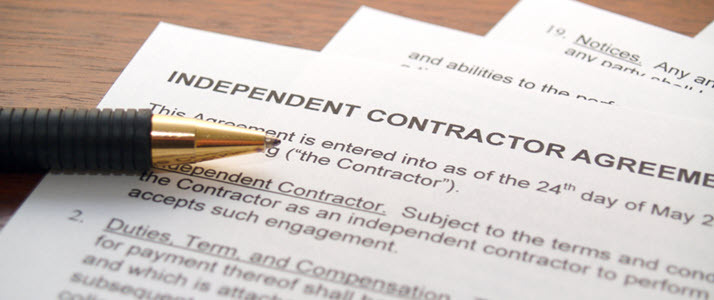Small Business and Gig Workers: 1099 Tax Compliance Considerations

The burden of handling tax compliance for independent contractors can be lessened by understanding the rules and planning early enough to meet the deadlines.
Independent contractors can be a flexible and cost-effective addition to your small business workforce, but hiring these workers means handling a different type of tax compliance.
Here's what you need to know, including how to prepare a 1099 for an independent contractor.
When is a worker an independent contractor?
When you hire a worker, you need to determine whether they count as an employee or an independent contractor. Hiring an independent contractor can be less expensive than hiring an employee because you don't provide benefits for them or cover the employer's share of payroll taxes for Social Security, Medicare and unemployment.
As a result, businesses have an incentive to classify workers as contractors. That's why the government has strict rules about when you can do so and will fine businesses that misclassify workers. The IRS has a few general guidelines to help you figure this out, but this is a very complex decision and it makes sense to get some expert advice.
So, how do you determine if a worker is an employee or an independent contractor? You need to determine the legal test that applies. First, you want to identify the jurisdiction. Second, the purpose. Once you determine what test applies, you need to apply the test to the worker's situation. These determinations are extremely fact-sensitive, and often are based on the totality of very particular (and sometimes unique) circumstances.
Typically, if workers have more control over how they do their work — such as the ability to set their own hours or work off-site and serve other clients at the same time — they are more likely to be considered contractors. If they don't meet these conditions, then they are more likely to be considered employees. IRS Form SS-8 can help you figure out how to classify different workers.
ABC tests
To add to an already complex area on the federal level, many states have their own tests. For example, California has adopted an ABC test for purposes of determining who is an employee. California, Massachusetts, Connecticut, Illinois, Vermont, Nevada, New Hampshire, and New Jersey are among those states that apply a version of an ABC test in at least one context.
In New Jersey, there are three different tests: the traditional "ABC" test for wage-hour and unemployment insurance, a 12-factor balancing test for workers' comp and EEO issues, and a 14-factor balancing test for taxes.
Sometimes employers will concede a worker is an employee for some purposes, but not concede employee status or waive arguments under other laws.
Workers generally are assumed to be employees – there is a presumption of being an employee – unless all three of these factors can be proven:
- The worker is free from the control and direction of the hirer in connection with the performance of the work;
- The worker performs work that is outside the usual course of the hiring entity's business; AND
- The worker is customarily engaged in an independently established trade, occupation, or business of the same nature as the work performed for the hiring entity.
This second factor – factor B – is the challenge for most employers. Here's a common example to illustrate the meaning of the "usual course of business." If a retail store hires an outside plumber to repair a leak in a bathroom or hires an outside electrician to install a new electrical line, the services of the plumber or electrician are not part of the store's usual course of business and the store would not be reasonably seen as being the employer of the plumber or electrician. This example is rather clear cut. The challenge, of course, is more nuanced situations which is why consulting legal counsel is advised.
How do you report taxes?
When you hire independent contractors, you don't manage tax withholding on their behalf — you pay them their earnings pre-tax, and then they handle their own tax withholding. Still, the IRS wants to know what independent contractors earn.
Starting with tax year 2020, the IRS has implemented a new form called the 1099-NEC, which covers roughly the same information for contractors that the Form 1099-MISC covered in terms of nonemployee compensation.
Each contractor you pay $600 or more in earnings should receive a 1099-NEC form. There are some exceptions; for instance, if the contractor is doing business as a C-Corporation or an S-Corporation, you usually do not need to send them a 1099. But for most independent contractors, you will need to prepare this form.
How to prepare a 1099 for an independent contractor
There are several steps to take into account here, but they're all necessary to ensure full compliance. Working with a trusted tax or payroll specialist can help relieve the burden of filing the right forms for the right people, sorting through regulations and accurately classifying employees.
- Ask new contractors for a W-9. Each time you hire a new independent contractor, ask them to give your payroll department a completed W-9 Form. On this form, they will list their name, address, filing status and tax identification number (SSN or EIN depending on their filing status.)
- Collect 1099 forms. You can order copies of the 1099 forms directly from the IRS, from an online tax/payroll service, at an office supply store or from your accountant. You can't just print the sample forms off the internet, though, as the IRS will not accept them.
- Complete a 1099 for each contractor. For each contractor, fill in their name, address, tax identification number and how much you paid them in compensation.
- Provide a 1099 for each contractor. They need this information to complete their own tax returns. You should also keep a copy for your own records.
- Send the IRS a copy of each 1099. You can mail the IRS the paper 1099s, or you can submit them digitally through their website. If you have more than 250 forms to submit, you must file electronically.
- Submit IRS Form 1096, if necessary. If you send the IRS paper copies of the 1099s, you must also complete IRS Form 1096, which summarizes all your 1099s. You don't need to send in this form if you file the 1099s electronically.
When is the deadline?
The Tax Cuts and Jobs Act of 2017 moved the 1099 deadline earlier for independent contractors. Your small business must submit these forms to the contractors and the IRS by Jan. 31 of the following tax year. For example, the 1099s for 2020 were due on Jan. 31, 2021.
If your business is late on the submission deadline, the IRS will charge a penalty. For small businesses, they charge $50 for each form that's late 30 days or fewer, $110 for each form that's more than 30 days late but sent in before Aug. 1, and $280 for each form that's sent in after Aug. 1 (or not at all). If you intentionally disregard sending in 1099s, the IRS charges $570 per missed form.
The burden of handling tax compliance for independent contractors can be lessened by understanding the rules and planning early enough to meet the deadlines. Enlisting the help of a partner that can automate this process and enable you to drive your business forward is well worth your consideration.
Automate how you manage your freelancers, 1099 contractors, and contingent workers through WorkMarket®, an ADP company.
Discover the all new RUN Powered by ADP®.
Small business has changed. So we've reimagined how your payroll and HR platform should perform. Experience faster, smarter, easier payroll and HR — purpose built for small businesses today. (www.ADP.com/PayrollBetter)



